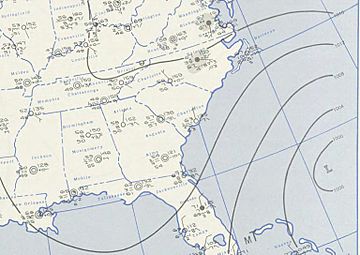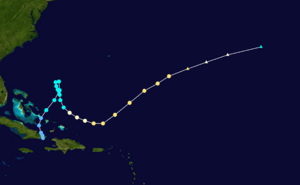Hurricane Greta (1956) facts for kids
| Category 2 hurricane (SSHWS/NWS) | |

November 2, 1956 weather map, featuring the storm
|
|
| Formed | October 30, 1956 |
|---|---|
| Dissipated | November 6, 1956 |
| Highest winds | 1-minute sustained: 100 mph (155 km/h) |
| Lowest pressure | 970 mbar (hPa); 28.64 inHg |
| Fatalities | 1 direct |
| Damage | $3.6 million (1956 USD) |
| Areas affected | Jamaica, Hispaniola, Cuba, The Bahamas, Southeast United States, Turks and Caicos Islands, Puerto Rico, Lesser Antilles |
| Part of the 1956 Atlantic hurricane season | |
Hurricane Greta was a very large Atlantic hurricane that formed late in the 1956 Atlantic hurricane season. It started as a tropical depression near Jamaica on October 30, 1956. At first, it had some features that were not typical for a tropical storm.
By November 2, Greta began to have strong winds, but the center of the storm was calm. On November 3, it grew stronger and became a tropical storm, getting the name Greta. The storm kept getting stronger and became a hurricane on November 4. It reached its strongest point with winds of about 100 mph (160 km/h).
Soon after, Greta started to get weaker as it moved over cooler ocean waters. By November 7, it changed into an extratropical cyclone over the central Atlantic Ocean. Even though Greta did not hit land directly as a tropical storm or hurricane, it caused huge waves. These waves affected many places. One person died in Puerto Rico, and the waves caused about $3.6 million in damage (in 1956 money).
Contents
How Hurricane Greta Formed and Moved
Hurricane Greta began from a weather disturbance near Jamaica on October 30, 1956. This area is called the Intertropical Convergence Zone, where winds from different directions meet. A Navy plane flew into the storm and found winds of 35 mph (55 km/h). They also found an area of low pressure, which is common for storms. At this time, it was called a tropical depression.
Even though a ship found that the storm had a "cold-core circulation," which is usually found in non-tropical storms, it was still called a tropical storm. On October 31, the depression moved near Haiti and then crossed the eastern part of Cuba. After that, it moved into the Atlantic Ocean. By November 1, the depression had moved through the central Bahamas and turned towards the northeast.
The pressure in the center of the storm dropped, and strong winds were felt over a large area. Because of this, the storm was upgraded to a tropical storm. Some people compared it to a Kona low, which is a large storm that forms near Hawaii. On November 2, the storm turned northwest because of an area of high pressure over the Atlantic.
First Hurricane Research Flights
Later that day, something special happened: the first time two planes flew into a hurricane for scientific research. An Air Force B-50 plane and a NHRP B-47 jet flew into Greta. The storm then made a counter-clockwise loop, which ended on November 3. During this time, many more research flights went into the storm. By then, the storm had also started moving southeast.
Greta continued to get stronger. On November 4, it became a hurricane. Later that same day, it reached Category 2 status on the modern-day Saffir–Simpson Hurricane Scale. After reaching this strength, the hurricane turned northeast and moved faster. A research flight measured the lowest pressure in the storm, which was 970 mbar.
Greta's Huge Size
When Greta was at its strongest, it was an incredibly large hurricane. The area with strong winds stretched about 1,200 miles (1,930 km) across. After reaching its peak strength, the storm started to move over cooler waters. This caused the storm's shape to become stretched out, but it did not get weaker for the next couple of days. On the morning of November 6, Greta changed into a very large and strong extratropical cyclone.
Impacts of Hurricane Greta
Even though Hurricane Greta did not hit land directly as a tropical storm or hurricane, its huge size caused very large waves. These waves were over 20 feet (6 meters) high across a big part of the Atlantic Ocean. The effects of the storm were felt as far away as the eastern United States. The National Weather Bureau told ships in the area to be careful.
St. Croix, an island, was almost cut off from supplies because of Greta. The storm's waves destroyed docks and stopped ships carrying food from reaching the island. Several small boats were destroyed by Greta's strong winds. Only small sailing boats could reach the island.
Along the coast of Jacksonville, Florida, buildings near the ocean had about $1.2 million in damage (in 1956 money). In Puerto Rico, waves up to 20 feet (6 meters) caused a lot of damage. One person died there after not leaving their home. Waves as high as 25 feet (7.6 meters) were seen in the Virgin Islands. In Guadeloupe, 80% of the port facilities were destroyed by the rough seas. In total, the damage from Greta was about $3.6 million (in 1956 money).


